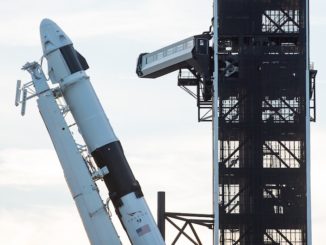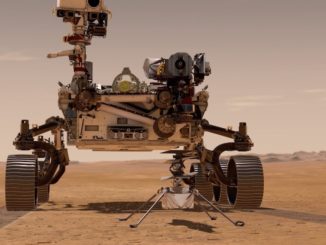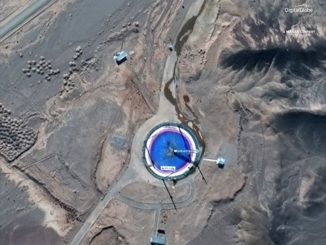Officials hailed an action-packed three-minute test flight Tuesday over Cape Canaveral that exercised the Orion spacecraft’s launch abort rocket, a key safety system on the capsule NASA is developing to carry astronauts back to the moon.
“We couldn’t have asked for a better flight, better mission, better performance,” said Don Reed, head of the Orion flight test management office. “That about sums it up.”
“It was really special for the program, and really a big step forward for us,” said Mark Kirasich, NASA’s Orion program manager at the Johnson Space Center in Houston.
Tuesday’s test flight, designated Orion Ascent Abort-2, cost approximately $256 million and is the Orion program’s last flight test before an unpiloted mission around the moon planned for late 2020, or more likely in 2021.
The Orion spacecraft is a major component of NASA’s newly-named Artemis program, which aims to return U.S. astronauts to the lunar surface in 2024. Under NASA’s current plans, astronauts will lift off from Earth riding Orion spacecraft mounted atop the giant Space Launch System rocket, a 322-foot-tall (98-meter) launcher which is several years behind schedule.
NASA says astronauts will ride on the Orion spacecraft and Space Launch System for the first time in the 2022 timeframe on a flight around the moon and back to Earth. That mission is named Artemis 2, and will be a precursor to a lunar landing attempt in 2024 on the Artemis 3 mission, according to NASA officials.
That assumes Congress funds fast-track moon landing program, which NASA Administrator Jim Bridenstine told CNN last month will require $20 billion to $30 billion in additional funding over the space agency’s previously-planned budget, which targeted a human lunar landing in 2028.
The successful outcome of the abort test Tuesday sets the stage for a flurry of work over the next one-to-two years to finish assembly and testing of the first Orion spacecraft capable of reaching the moon, along with final construction and a test-firing of the first SLS core stage, the component responsible for the program’s most recent delays.
Tuesday’s flight used a simplified Orion capsule built specifically for the launch escape test, crowned with an abort system identical to the unit that will be used on crewed launches.
NASA’s Orion spacecraft is boosted towards a successful in-flight abort test, designed to save the astronauts who will travel aboard the spacecraft in the coming years. The launch, to an altitude of 33,000 feet was carried out by a @northropgrumman Minotaur 4 first stage booster. pic.twitter.com/kxCJo8qdnA
— Ben Cooper (@LaunchPhoto) July 2, 2019
The vehicle rocketed into the sky over Cape Canaveral Air Force Station at 7 a.m. EDT (1100 GMT) Tuesday.
A converted SR118 rocket motor from the U.S. Air Force’s inventory of decommissioned Cold War-era Peacekeeper missiles provided a half-million pounds to propel the capsule off of pad 46 at Cape Canaveral. The booster was weighted down to allow it reach just the right altitude, speed and aerodynamic pressure for the abort test, mimicking the conditions the Orion spacecraft will encounter while riding the must larger Space Launch System.
“We actually had to add over 100,000 pounds (45 metric tons) of ballast to it just to slow it down, because it’s pretty sporty,” said Jenny Devolites, NASA’s test director for Tuesday’s flight.
The 93-foot-tall (28-meter) single-stage vehicle climbed to an altitude of 31,000 feet (about 9,500 meters) in approximately 50 seconds, reaching a speed of Mach 1.08 before the test capsule’s on-board computer triggered an abort command. The command initiated series of rocket firings and maneuvers using an abort system mounted on top of the Peacekeeper motor and Orion capsule.
The abort motor instantly pulled the Orion test capsule away from the Peacekeeper’s SR118 booster moments before the rocket exhausted its propellant supply and burned out.
The four-nozzle abort motor quickly ramped up to 400,000 pounds of thrust and fired more than five seconds, accelerating the capsule with the force of about seven Gs to out-run the SR118 booster.
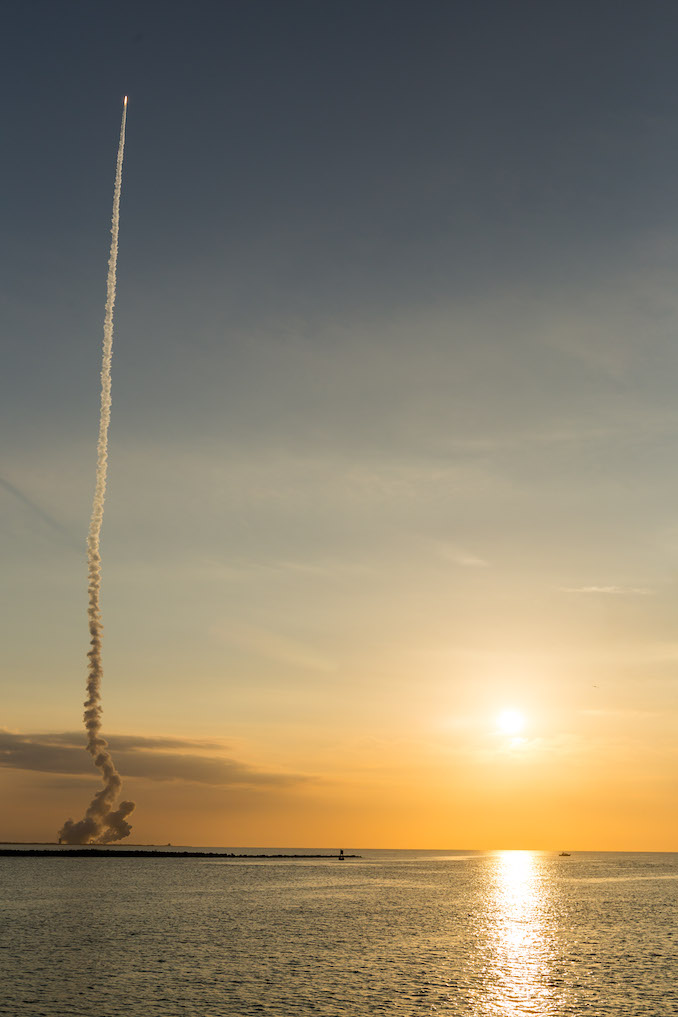
The attitude control motor located at the pointy end of the abort tower stabilized the capsule during the maneuver to pull away from the booster. Fifteen seconds after the start of the abort, the attitude control motor began reorienting the capsule end-over-end to turn the craft’s heat shield toward the ground.
The Orion capsule’s launch abort system looks a lot like the escape tower flown on top of the Saturn 5 moon rocket in the Apollo program. But the attitude control motor is a major difference, consisting of eight variable-thrust nozzles placed at 45-degree angles around the abort tower, and each with the ability to be independently controlled and modulated.
The Apollo spacecraft had a non-vectoring “pitch” motor to send the capsule in one direction during a launch escape event. The upgrade gives the Orion spacecraft the ability to escape from its launcher under more extreme conditions than possible on Apollo missions.
The Orion’s computer senses the vehicle’s orientation during an abort and sends commands to the attitude control motor to move the position of pintles inside each nozzle to adjust thrust and keep the vehicle properly pointed.
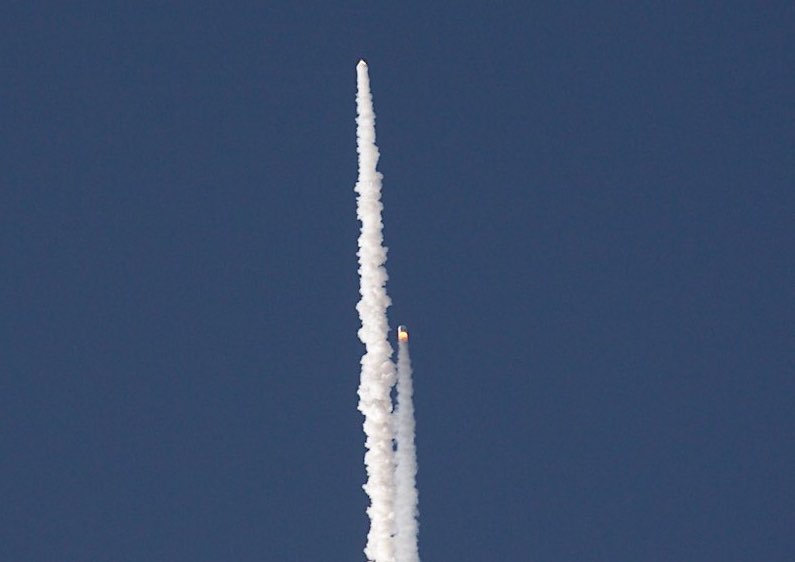
Once the Orion capsule was in the correct bottom-down orientation, a third rocket motor on the abort system ignited to jettison the test vehicle. At that point in a real abort scenario, with astronauts inside, a series of parachutes would begin unfurling to slow the spaceship for splashdown.
NASA did not include parachutes on Tuesday’s test flight.
If astronauts flew on Tuesday’s test launch, “they would have been fine, with parachutes of course,” Reed said. “But all the way up to the point we jettisoned, they would have been fine.
“People ask that question, why do we not have parachutes,” Reed said. “And the simple answer is we’ve done 47 (drop) tests at Yuma (Proving Ground in Arizona). We’ve done ground testing, so we know how the environment impacts the components that are part of that system.”
NASA finished qualification testing of the Orion parachutes last year, and the chutes worked as designed during the Orion capsule’s return from a test flight in Earth orbit in 2014.
An agency spokesperson said the decision not to include the parachutes, and their associated deployment mechanism and control systems, saved around $30 million, and allowed teams to conduct the abort test sooner.
Without the chutes, the Orion capsule plummeted into the Atlantic Ocean around 7 miles (11 kilometers) east of Cape Canaveral, hitting the water at an estimated 300 mph (480 kilometers per hour) around 3 minutes, 12 seconds, after liftoff, Reed said. The spent Peacekeeper booster and abort system also impacted the ocean, sending plumes of water hundreds of feet into the air.
All the components were designed to sink.
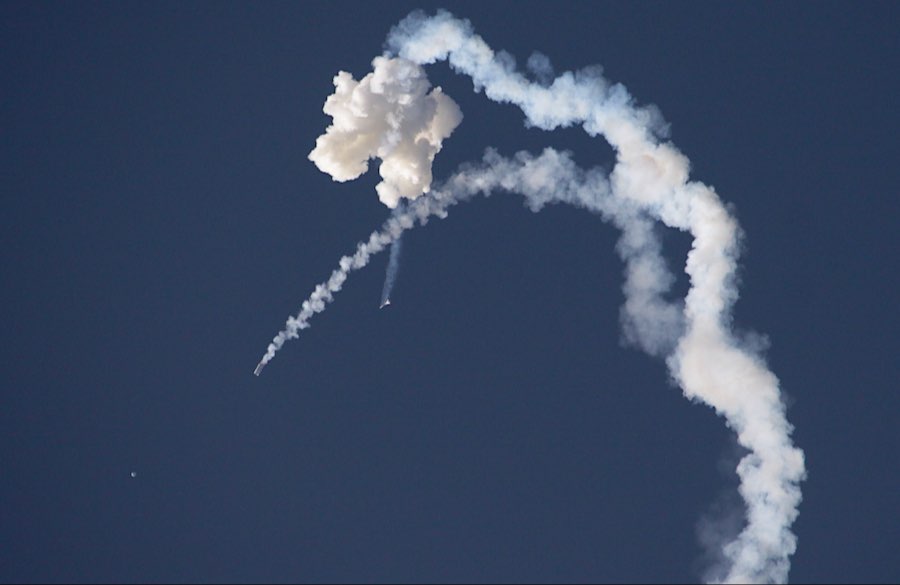
On the way back to the ground, the Orion test capsule transmitted data recorded from nearly 900 temperature, pressure and acoustic sensors back to engineers for analysis. The vehicle also ejected 12 data recorders, all of which were retrieved by recovery boats in less than 90 minutes, Reed said.
A quick assessment of the data suggested the abort system functioned as intended.
“One of the most important parts of the test was to see how the attitude control motor, that’s one of the three motors, performed,” Kirasich said. “Right after the test was completed, we all ran up to the console of the LAS (launch abort system) operator and each of us watched the plots.
“It’s a single motor that (has) eight valves around the circumference, and you have to modulate the valves, first of all to direct the thrust, but you also have to keep the motor pressure steady,” Kirasich said. “That’s a key part of this technology. The internal motor pressure was rock solid, straight line, and it had excellent control characteristics.”
The ascent abort test Tuesday came after a series of ground test-firings of the Orion abort system, and a flight test conducted in May 2010 to simulate an escape from an explosion on the launch pad.
The pad abort in 2010 flew with a prototype abort system. The ascent abort Tuesday tested a fully functioning abort apparatus, the same configuration to be relied upon by astronauts.
No astronauts were on-board for Tuesday’s flight, but veteran space flier Randy Bresnik said before the test that he was eager to see the results of the experiment.
“It is so important because it’s the only one of its type in the dynamic flight environment, the environment where it’s going to be needed most,” Bresnik said.
On a real space mission, the Orion spacecraft would command an abort automatically if sensors detected a malfunction in the launch vehicle. Astronauts riding on the spacecraft will also be able to manually initiate an abort, Bresnik said.
The emergency landing of Russian cosmonaut Alexey Ovchinin and NASA flight engineer Nick Hague after a failed Soyuz rocket launch in October 2018 illustrated the importance of a launch abort capability, Bresnik said.
“We have to prepare for this, even though it’s a low likelihood of happening,” Bresnik said. “It had been 35 years since anyone on the planet had to exercise their launch abort system (before the Soyuz abort last year).
Hague himself chimed in on Twitter from the International Space Station a few hours after Tuesday’s abort test. He successfully launched earlier this year on a subsequent Soyuz flight to the station.
“As someone who has had his life saved by a launch abort system, I can attest that today was a truly significant milestone in the Artemis program,” Hague tweeted. “Thank you to all associated with the … test for your hard work and dedication, and congratulations on a successful test!”
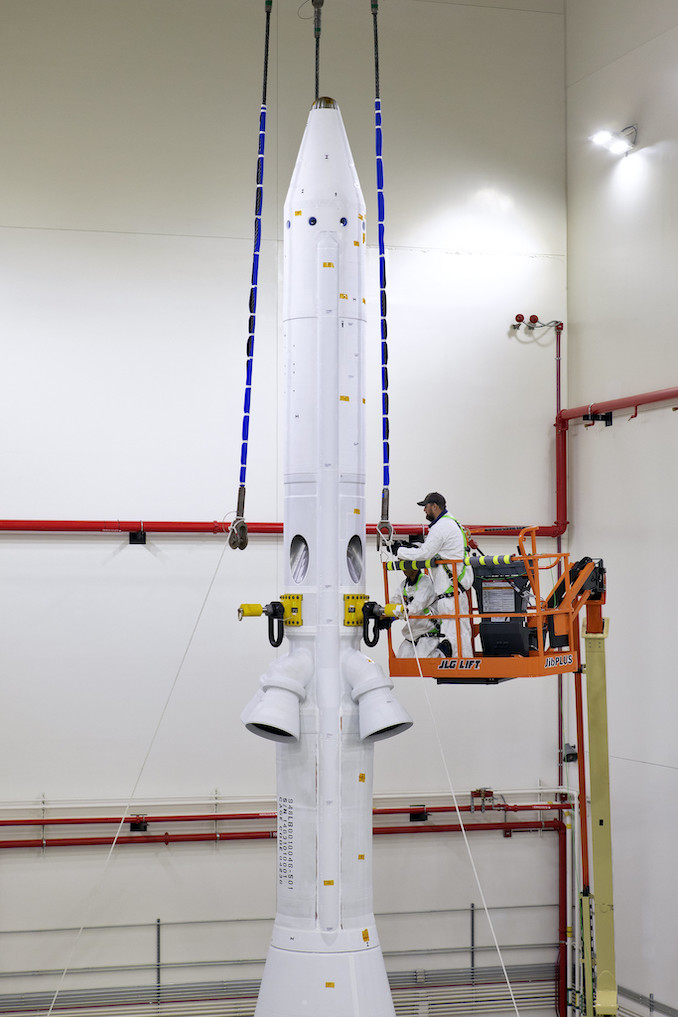
Ground test-firings of the abort system’s rocket motors will continue over the next year, Kirasich said. Teams have accomplished four of the escape system’s nine required qualification firings — three for each rocket motor — for human flights.
Lockheed Martin, NASA’s prime contractor on the Orion program, oversees development of the launch abort system. Northrop Grumman Innovation Systems, formerly known as Orbital ATK, supplied the abort and attitude control motors, while Aerojet Rocketdyne built the jettison motor, the last of the three abort system rockets to fire Tuesday.
Northrop Grumman also partnered with the U.S. Air Force to ready the Peacekeeper-derived abort test booster for launch. The booster is also based on the Minotaur 4 rocket used to launch small satellites into orbit.
“In Orion, crew safety and spacecraft reliability are very high priorities for us, and our launch abort system is a key safety feature of the spacecraft,” Kirasich said before Tuesday’s test flight. “It will protect the crew members who fly on-board Orion. It will protect them during the most challenging part of the mission, which is the ascent phase.”
Space shuttle crews had no ability to use an abort rocket to escape a catastrophic failure during launch.
The new commercial crew capsules developed by Boeing and SpaceX to ferry astronauts to the International Space Station both have “pusher” escape systems, employing liquid-fueled rocket engines along the rear circumference of the vehicles to propel astronauts away from a launcher in an emergency.
The Apollo, Soyuz and Orion designs utilize “puller” abort systems.
NASA selected Lockheed Martin to begin developing the Orion spacecraft in 2006 under the auspices of the space agency’s now-defunct Constellation program, which started under the George W. Bush administration in the aftermath of the loss of the shuttle Columbia and its seven-person crew in 2003.
After the Columbia accident, the Bush White House directed NASA to end the shuttle program after completing the International Space Station, allowing the agency to re-focus on deep space exploration, with an objective of returning humans to the moon’s surface by 2020.
But the Constellation program ran into numerous delays and cost estimates crew, prompting President Obama to cancel the program in 2010. A year later, the White House and Congress agreed on a new strategy for NASA, salvaging work already completed on the Orion program and kicking off development of a new rocket called the Space Launch System for eventual missions to Mars.
The Orion and Space Launch System programs have encountered more difficulties since 2011, delaying the first launch of an unpiloted version of the crew capsule on the SLS from 2017 until no earlier than late 2020, or more likely some time in 2021.
NASA and Lockheed Martin conducted an Orion test flight in Earth orbit in December 2014 to test the capsule’s heat shield at the speeds it will encounter on re-entry from the moon. Engineers also conducted the Orion pad abort test in 2010.
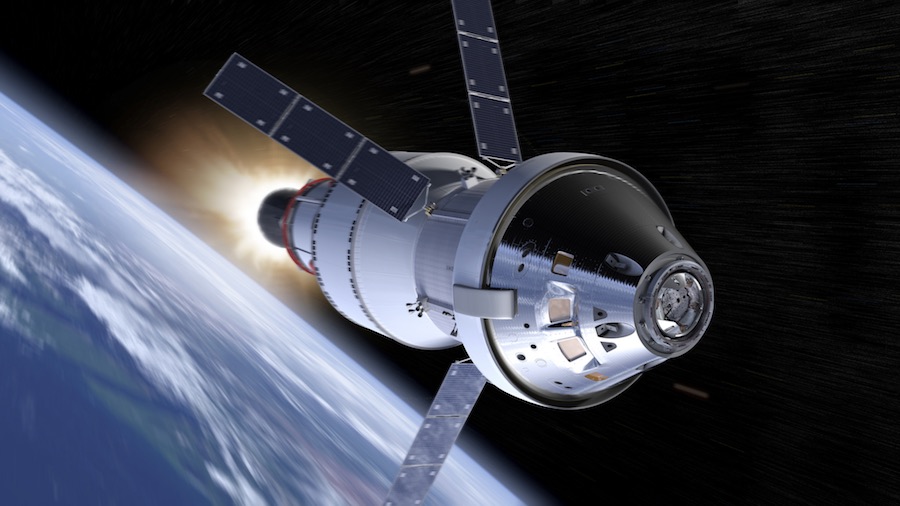
NASA has spent around $16 billion on the Orion program since its start, according to Laura Forczyk, a space policy analyst. The SLS program has cost around $14 billion to date, she said earlier this year.
The first SLS/Orion mission, known as Artemis 1, will send the Orion spacecraft on a flight lasting at least 25 days in a distant orbit around the moon, then back to Earth. Lockheed Martin engineers at the Kennedy Space Center are readying the Orion capsule for Artemis 1, along with its European-built power and propulsion module.
The Artemis 2 mission, currently set for launch in 2022 or 2023, will be the first Orion flight around the moon with astronauts.
In the meantime, NASA and commercial partners will build and launch elements of the Gateway, a mini-space station in lunar orbit that will be a stopover and safe haven for astronauts on the way to the moon’s surface.
Email the author.
Follow Stephen Clark on Twitter: @StephenClark1.

